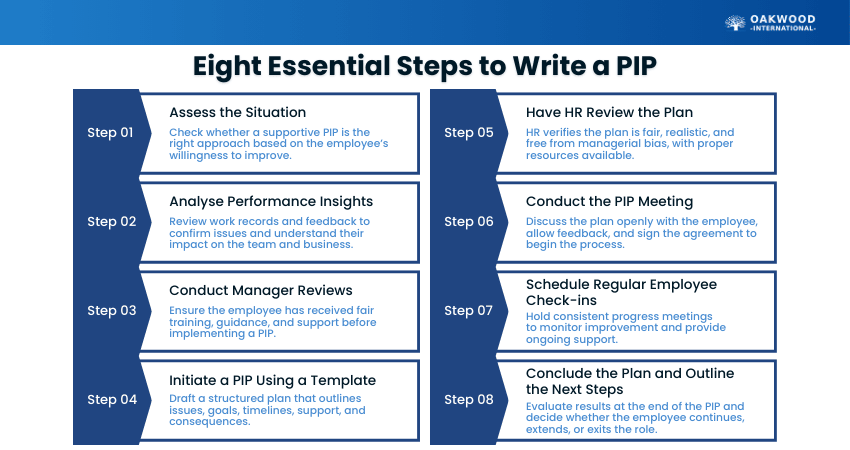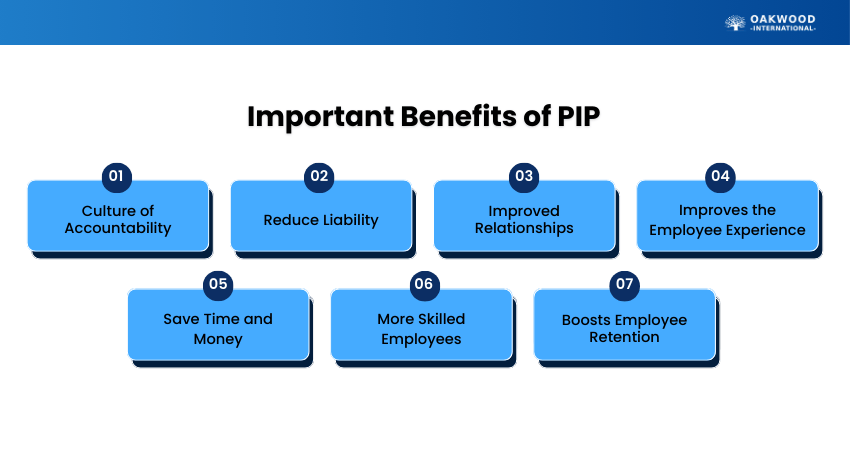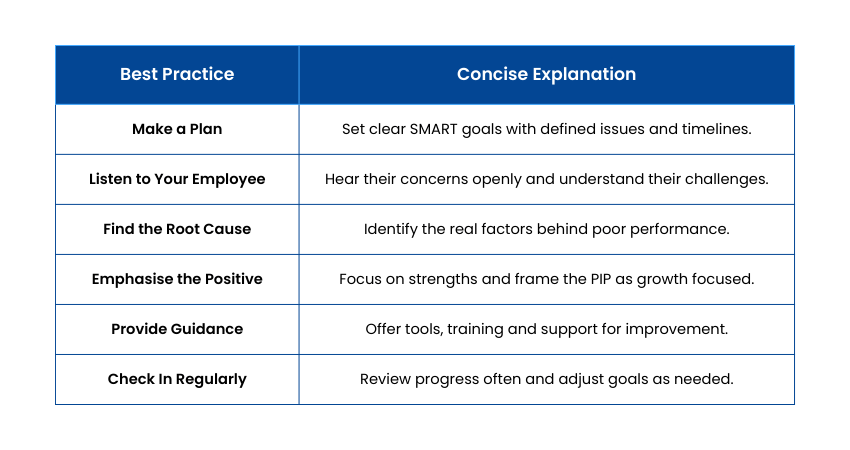Table of Contents


Have you ever managed a talented employee who suddenly started struggling? In team, the manager wants every member to succeed, but the challenging part is helping them get on track. This is why Performance Improvement Plan (PIP) is a powerful tool to provide structured and meaningful support.
By applying the right approach, a Performance Improvement Plan (PIP) can help to rebuild confidence, restore productivity, and help your employee meaningfully. In this blog, you will learn about PIP, how to write on, its benefits and much more. Keep reading ahead to learn more!
Table of Contents
1) What is a Performance Improvement Plan (PIP)?
2) What a Performance Improvement Plan (PIP) Form Should Include?
3) How to Write a Performance Improvement Plan (PIP) in 8 Steps?
4) Benefits of Performance Improvement Plan (PIP)
5) When are Performance Improvement Plans Implemented?
6) Do Performance Improvement Plans Actually Work?
7) Examples of Performance Improvement Plans (PIP)
8) Best Practices for Performance Improvement Plans
9) Conclusion
What is a Performance Improvement Plan?
A Performance Improvement Plan (PIP) is a formal, structured document designed to help employees who are not meeting job expectations improve their performance. Rather than rushing into disciplinary action or termination, a PIP offers a second chance by outlining specific performance issues, measurable goals, support resources, and a clear timeline for improvement.
Keys Focus Areas:
a) A PIP is usually initiated by a manager or HR
b) It acts as both a guidance tool and an accountability framework
c) Identifies performance gaps in areas like productivity and communication
d) Clearly defines what success looks like to improve customer satisfaction
e) Emphasises collaboration over punishment
f) Includes regular check-ins, training, and mentoring support
g) Success leads to role continuation; failure may lead to further action
h) Promotes talent retention and performance improvement
What a Performance Improvement Plan (PIP) Form Should Include?
A Performance Improvement Plan (PIP) must outline how an employee can improve their performance within a set period. Here is the key elements required to complete a PIP
a) Employee Information: Name, job title, department, and PIP issue date.
b) Specific Performance Metrics for Improvement: Performance areas needing improvement
c) Goals and Development Activities: Actions and target dates for performance improvement
d) Final Target Completion Date: Deadline for completing the PIP plan
e) Expected Results: Specific, measurable outcomes the employee needs to accomplish
f) Schedule of Profess Review Meetings: Dates for review meetings and progress recording
g) Final Review and Results: Summary of the overall performance at the end of the PIP period
h) Signatures and Agreement: Confirms agreement to the PIP through the employee and supervisor signatures
How to Write a Performance Improvement Plan (PIP) in 8 Steps?
A Performance Improvement Plan must be tailored to individual employees. Below is a list of essential steps to design an effective PIP.

1) Assess the Situation
Begin by assessing the right approach for writing the Performance Improvement Plan. A PIP works effectively when an employee demonstrates a willingness to improve. If someone is not engaged or unresponsive to feedback, alternative actions, such as warning or termination, may be appropriate.
2) Analyse Performance Insights
Regularly review the employee’s work and record performance to confirm any underlying issues. Also, communicate with managers and team members, collect documented examples, and review past performances. You can identify how their performance affects deadlines, team dynamics and business results.
3) Conduct Manager Reviews
It is crucial to analyse if the employee is provided with proper guidance, training, and support. Additionally, review onboarding, past coaching, and manager expectations to ensure the manager is committed to helping employees succeed.
4) Initiate a PIP Using a Template
By utilising the collected information, it is time to draft the Performance Improvement Plan. It must include:
a) Employee Details
b) Performance Issues with Examples
c) Clear Goals and Scalable Targets
d) Timeline and Check-in Meetings
e) Support methods, such as training or mentoring
f) Consequences if goals are not met
5) Have HR Review the Plan
Here, HR checks the accuracy of the Performance Improvement Plan. They make sure goals are achievable, timelines are realistic, and there is no bias on the part of the manager. HR verifies whether the employee will receive the resources for successful completion of the plan.
6) Conduct the PIP Meeting
Now it is time to meet the employee, manager and HR representative to discuss the plan. It is important to keep the communication supportive and transparent. Encourage the employee to share input, ask questions and raise concerns. Once finalised, ensure the document is signed by the manager and employee and approved by HR.
7) Schedule Regular Employee Check-ins
During the Performance Improvement Plan period, schedule regular check-ins. These meetings help to monitor progress, address difficulties, and offer support throughout the process. This confirms the employee has relevant resources, tools, and training to succeed.
8) Conclude the Plan and Outline the Next Steps
At the end of the PIP period, schedule a final meeting to evaluate performance. Recognise improvements, clarify expectations for the future and discuss the next steps. If goals are successfully met, the employee may return to normal performance expectations. If goals are not met, determine the appropriate action in line with company policy.
At the end of the Performance Improvement Plan, schedule a final meeting to evaluate the progress of the employee. Acknowledge, celebrate and discuss expectations before going forward. If goals are met, the closing meeting can be conducted. In case goals are not met, determine the appropriate step.
Transform your team dynamics – Register for expert-led Talent Acquisition Training today!
Benefits of a Performance Improvement Plan (PIP)
Here are some of the benefits of a Performance Improvement Plan:

1) Culture of Accountability
PIPs promote a workplace culture where expectations are clear and accountability is embraced. Employees understand their roles and are encouraged to take ownership of their performance. This fosters responsibility and raises the overall performance bar.
2) Reduce Liability
From a legal standpoint, a documented PIP demonstrates that the company took fair, consistent steps to address performance issues. If termination becomes necessary, it reduces the risk of wrongful dismissal claims by showing a transparent and structured process was followed.
3) Improved Relationships
Open and constructive dialogue during a PIP can enhance trust between managers and employees. It shifts the narrative from conflict to collaboration, helping to rebuild strained relationships and create a more communicative work environment.
4) Improves the Employee Experience
When employees are supported instead of immediately penalised, it signals that their development matters. This not only boosts morale but also helps employees feel valued and understood, improving their day-to-day experience at work.
5) Save Time and Money
It is costly to replace an existing employee. A PIP provides a more efficient alternative by helping existing team members improve. This process also succeeds in their roles, saving on recruitment, onboarding, and training expenses.
6) More Skilled Employees
Employees going through a PIP often gain new skills through targeted training and coaching with extra care. Even if they don’t meet every objective, they usually emerge more capable, self-aware, and better equipped to handle future responsibilities.
Level up your people skills with Talent Management Training - Inspire your workforce daily!
7) Boosts Employee Retention
When employees are supported during difficult times tend to stay long-term with the organisation. A thoughtful Performance Improvement Plan can prevent premature exits, reduce turnover, and foster a stronger, more stable workforce.

When are Performance Improvement Plans Implemented?
Performance Improvement Plans are introduced to support improvement, provide clear expectations, and help employees reach professional standards. A PIP must be implemented during appropriate situations, such as:
1) Understanding the Root Cause
Employers must identify why the employee is underperforming. At times, the problem might not be associated with the employee but with external workplace factors. This can include:
a) Lack of proper resources or tools
b) Unrealistic expectations from the manager
c) Work-related stress due to bullying or harassment
2) When the Issue Lies with the Employee
If the problem is linked to the employee, underperformance must not be solely due to lack of effort. It can also mean
a) Insufficient training during onboarding
b) Struggling to adapt to the new system
c) Physical or mental health challenges
d) Personal issues affecting productivity
3) Failure of Informal Steps
A PIP should be considered when underperformance continues despite informal support. If an employee repeatedly misses deadlines, delivers incomplete work or shows ongoing productivity concerns after coaching, a structured PIP becomes appropriate.
4) Immediate PIP Causes
In some scenarios, a Performance Improvement Plan can be implemented from the onset. Generally, this happens when
1) Employee refuses to take accountability for any performance issue
2) Underperformance levels are serious or harmful to the objectives
Do Performance Improvement Plans Actually Work?
Yes, Performance Improvement Plans (PIPs) can be highly effective, but their success depends on how they’re implemented and the intent behind them. When approached with genuine support and clear communication, PIPs offer struggling employees a structured opportunity to turn things around.
They provide clarity on expectations, specific goals, timelines and the resources needed to improve. Many employees respond positively to this structure, especially when they feel their manager is invested in their growth.
Build strong leadership skills and qualities with the Successful People Management and Team Leadership Course – Join now!
Examples of Performance Improvement Plans (PIP)
Here is a list of five practical examples of Performance Improvement Plans in workplaces:
Example 1: Irregular Attendance
The employee has a recurring pattern of absenteeism, disrupting workflow, and affecting productivity.
Main Goal:
Reduce absenteeism to an acceptable level ( minimum 95% monthly attendance)
Measurable KPIs:
a) Absenteeism rate
b) On-time project completion rate
Action Plan:
a) Discuss attendance concerns with the employee
b) Set clear attendance expectations and explain the consequences if they are not followed
c) Address possible root causes for providing support
d) Implement formal attendance tracking
Example 2: Missed Deadlines
When the employee consistently fails to meet deadlines, it leads to project delays and affects team output.
Main Goal:
Meet all project deadlines on a consistent basis
Measurable KPIs:
a) On-time project completion rate
b) Task completion rate
Action Plan:
a) Conduct a time-management assessment to identify gaps
b) Provide training on prioritisation, planning tools, and techniques
c) Introduce a progress-tracking system for deadlines
d) Encourage open communication with the supervisor
e) Reinforce clear deadline expectations and mention the consequences
Example 3: Inadequate Customer Service
When the employer receives negative customer feedback regarding attitude, communication, and problem-solving.
Main Goal:
Deliver consistent high-quality customer service to meet customer expectations
Measurable KPIs:
a) Customer satisfaction scores
b) Number of customer complaints
c) Number of positive feedback
Action Plan:
a) Provide customer service training
b) Use role-playing exercises to handle difficult scenarios
c) Set up a system to collect and review customer feedback
d) Recognise employees who consistently deliver strong service
Example 4: Unprofessional Work Behaviour
This is when an employee frequently arrives late, causing disruption to shift changes.
Main Goal:
Arrive on time for 95% of workdays to improve team engagement and maintain professionalism.
Measurable KPIs:
a) Percentage of days the employee arrives on time
b) Frequency of instances where colleagues must cover their responsibilities
Action Plan:
a) Employees must check in with the supervisor daily at 8 a.m.
b) Punctuality will ensure that previous-shift nurses can clock out on time
c) The supervisor will record daily arrival times
Example 5: Poor Leadership
When a team lead is struggling to guide their team effectively. Here, issues include unclear project direction, missed deadlines, or a lack of feedback.
Main Goal:
To strengthen leadership effectiveness
Measurable KPIs:
a) Check the team clarity score in project expectations
b) Timely feedback rate
c) On-time project completion rate
d) Team satisfaction score
e) Reduction in avoidable errors
f) Reduction in avoidable errors
Action Plan:
a) Provide training in leadership and time management
b) Conduct regular check-ins
c) Provide feedback consistently
Best Practices for Performance Improvement Plans
A well-executed Performance Improvement Plan (PIP) is a roadmap to employee success. These best practices ensure the process is fair, constructive, and truly effective:

Make a Plan
Clearly define performance issues and desired outcomes.
a) Use the SMART method: Specific, Measurable, Achievable, Relevant, Time-bound.
b) Make sure improvement targets are directly tied to the employee’s role and responsibilities.
c) Provide enough time for improvement while keeping urgency in mind (typically 30–90 days).
d) Use written communication to avoid misunderstandings and ensure transparency.
Tip: Draft the plan in collaboration with HR for structure and fairness.
Become the leader everyone wants to work with – Join Workforce Resource Planning Training now!
Listen to Your Employee
Allow the employees to share their perspectives and challenges.
a) Show empathy and keep the discussion open and respectful.
b) Use prompts like “What’s been difficult lately?” or “How can we support you better?”
c) Performance issues may stem from personal, team, or systemic problems.
d) Let the employee know their input will be treated with care and used constructively.
Tip: Ask open-ended questions like “What do you think is holding you back?”
Find the Root Cause of the Issue
a) Don’t just address symptoms; understand what’s driving poor performance.
b) Evaluate factors like unclear expectations, lack of skills, or workplace issues.
c) Low performance causes a lack of recognition or misalignment with the role.
d) Life events or health concerns may affect focus and productivity.
e) Combine observation, metrics, and peer insights to get a complete picture.
Tip: Use one-on-one meetings or assessments to dig deeper.
Emphasise the Positive
a) Highlight the employee’s strengths and potential.
b) Position the PIP as a development opportunity, not a warning.
c) Remind them of their value and previous successes in the role.
d) Make it clear that the aim is to help them thrive within the organisation.
e) Discuss how this improvement could open doors for future opportunities.
Tip: Use encouraging language like “We believe in your ability to improve.”
Provide Guidance
a) Ensure the employee has access to everything needed to succeed, such as software, courses, job aids, etc.
b) Offer tools, training, and regular support.
c) Be actively involved in their progress, not just the evaluator.
d) Suggest workshops, e-learning modules, or webinars to bridge skill gaps.
e) Create a safe space for employees to ask for help when needed.
f) As confidence builds, tailor guidance to match evolving needs.
Tip: Assign a mentor or schedule weekly coaching sessions.
Check-in Regularly
a) Schedule consistent progress reviews (weekly or bi-weekly).
b) Use check-ins to give feedback, resolve issues, and adjust goals.
c) Keep written records to ensure clarity and reference.
d) Celebrate small wins and realign if performance veers off track.
e) Adapt timelines or tasks based on what is realistic and reasonable.
Tip: Keep a written summary of each meeting for transparency.
Conclusion
A Performance Improvement Plan is about helping someone get back on track. With clear goals, honest conversations, and the right support, employees can improve and feel more confident in their roles. For managers, it's a chance to guide rather than punish. When handled with care, a PIP can turn a tough situation into a win for both the employee and the team.
Strengthen your people skills and lead confidently with People Management Courses today!


 Back
Back



 Back to Catagories
Back to Catagories





 + 44 7452 122728
+ 44 7452 122728










